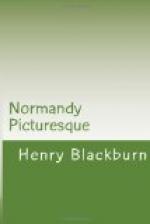We draw attention to this so pointedly at the outset, because it is altogether inconsistent and wide of our purpose in making a quiet, and we may add, economical, visit to Normandy, to do, as is the general custom with travellers—spend half their time and most of their money in Paris.
Thus much in outline for the ordinary English traveller on a holiday ramble; but the artist or the architect need not go so far a-field. If we might make a suggestion to him, especially to the architect, we would say, take only the first four towns on our list (continuing the journey to Coutances, or returning by Rouen if there be opportunity), and he will find enough to last him a summer.[4] If he has never set foot in Normandy before we may promise him an aesthetic treat beyond his dreams. He will have his idols both of wood and stone—wood for dwelling, and stone for worship; at PONT AUDEMER, the simple domestic architecture of the middle ages, and at LISIEUX, the more ornate and luxurious; passing on to CAEN, he will have (in ecclesiastical architecture) the memorial churches of William the Conqueror, and, in the neighbouring city of BAYEUX (in one building), examples of the ‘early,’ as well as the more elaborate, gothic of the middle ages.
If the architect, or art student, will but make this little pilgrimage in its integrity, if he will, like Christian, walk in faith—turning neither to the right hand nor to the left, and shunning the broad road which leads to destruction—he will be rewarded.
There are two paths for the architect in Normandy, as elsewhere—paths which we may call the ‘simple right’ and the ‘elaborate wrong,’ and the right path is sometimes as difficult to follow as the path of virtue.
But both artist and amateur will revel alike in the beauty of landscape, in the variety of form and colour of the old buildings, and in the costume of the people; and we cannot imagine a more pleasant and complete change from the heat and pressure of a London season than to drop down (suddenly, as it were, like a bird making a swoop in the air), into the midst of the quiet, primitive population of a town like Pont Audemer, not many miles removed from the English coast, but at least a thousand in the habits and customs of the people. An artist of any sensibility could scarcely do it, the shock would be too great, the delight too much to be borne; but the ordinary reader, who has prepared his mind to some extent by books of travel, or the tourist, who has come out simply for a holiday, may enjoy the change as he never enjoyed anything before.




